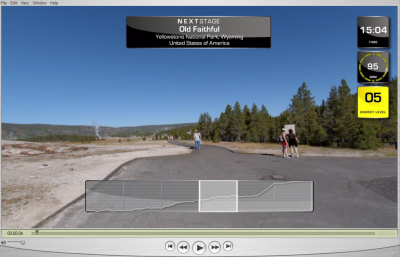
Whenever I teach an Indoor Cycling class, I try to create an experience that takes the students beyond exercise. A class can affect students even more when video is added. So far, though, video has been used in classes more as a backdrop to create atmosphere than to augment the experience.
The trick to teaching with video is to act as if the ride is real.
When we teach, we can make our students feel that they”™re somewhere else through cueing, guided imagery and choice of music. When we dim the lights, play the perfect song, and describe riding through the desert under a full moon on a road with no cars, we can immerse the student in that imagery. Whatever doesn”™t add to it detracts.
Can you imagine that same scenario with a disco ball? No congruence. The same holds true for leading a ride profile that has nothing to do with the video playing behind you, and never even referencing it. The video grabs the student”™s attention from time to time but doesn”™t create virtuality on the ride.
To make video more than a diversion or backdrop, we must embrace it. Then we can create an experience in our classes like never before.
John Chambers of Cisco Systems describes “telepresence” as technology that makes us feel present somewhere other than our true location. A popular application is videoconferencing.
Telepresence allows our students to feel themselves in the video. This leads to immersion, where a student”™s self-awareness blends into the absorbing surrounding environment.
Video can create immersion in our students. The acronym ‘SIT”™ describes the coaching process:
- Simulation references the video as a real-life scenario. “We”™re on Highway 89 in the Arizona Desert, heading to Glen Ferry National Park. It”™s 95 degrees with zero percent humidity. The road rolls, and we”™re moving at 25 mph.”
- Interaction adapts the training directly to the video. “Our next stage is a straight-line climb, averaging 5%. Stay in the saddle and pedal at 70 RPM. Match your pedalling to the beat of the music.”
- Telepresence helps the class feel present in the video through cueing (words and voice), music (genre, tempo, structure), and the workout (cadence, resistance, intensity and choreography). “You”™ve ridden hills like this before. Relax. Control your breathing and fall into the tempo of the music. It”™s mellow. Let the music carry you up the hill. We”™ll peak our HR at the summit of this climb. We”™ll ride the first 3 minutes in the saddle and stand for the last 2, increasing resistance every 60 seconds without losing one RPM.”
With this link, (it's a big HD file so you may need to wait for it) you can download a segment of an HD virtual class, created by the Indoorcycling Group of North America, in conjunction with Virtual Active. When we use video this way -- selecting words, music and a workout that make sense to us with the footage -- our students achieve immersion. Note from John - you really want to watch that video 🙂
The degree of immersion will vary with the club setting and your comfort, which grows with experience. But even instructors with less experience can create immersion. As your coaching develops, your students”™ immersion will deepen. The focus is less on the instructor and more on the video and the thrilling sense of forward motion it creates.
Video quality and high-def imagery enhance the forward motion feel, thus immersion. Virtual Active”™s video enhances indoor cycling in a way that”™s been missing till now.
You are now ready to begin delivering a complete and synergistic experience for your students.
Podcast: Play in new window | Download
Originally posted 2011-12-12 20:03:15.
- Spinning Our Wheels:Can’t We Go Faster? - February 24, 2024
- Still More on Motivation - January 1, 2024
- Differentiation:ICG® Academy Opens in San Francisco - December 23, 2023



Damn! (Make that Hot Damn.) My favorite part: “I don’t think we’re gonna make it.” Absolutely loved it.